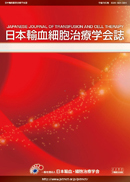Volume 60, Issue 1
Displaying 1-9 of 9 articles from this issue
- |<
- <
- 1
- >
- >|
Picture in Transfusion Medicine & Cell Therapy
-
2014Volume 60Issue 1 Pages 1-2
Published: February 28, 2014
Released on J-STAGE: March 20, 2014
Download PDF (291K)
Review
-
2014Volume 60Issue 1 Pages 3-11
Published: February 28, 2014
Released on J-STAGE: March 20, 2014
Download PDF (404K)
Originals
-
2014Volume 60Issue 1 Pages 12-17
Published: February 28, 2014
Released on J-STAGE: March 20, 2014
Download PDF (567K) -
2014Volume 60Issue 1 Pages 18-24
Published: February 28, 2014
Released on J-STAGE: March 20, 2014
Download PDF (316K) -
2014Volume 60Issue 1 Pages 25-31
Published: February 28, 2014
Released on J-STAGE: March 20, 2014
Download PDF (1325K)
Case Report
-
2014Volume 60Issue 1 Pages 32-37
Published: February 28, 2014
Released on J-STAGE: March 20, 2014
Download PDF (423K)
Activity Report
-
2014Volume 60Issue 1 Pages 38-43
Published: February 28, 2014
Released on J-STAGE: March 20, 2014
Download PDF (1703K)
Letter to the Editor
-
2014Volume 60Issue 1 Pages 44-45
Published: February 28, 2014
Released on J-STAGE: March 20, 2014
Download PDF (136K)
Secondary Publication
-
2014Volume 60Issue 1 Pages 46-58
Published: February 28, 2014
Released on J-STAGE: March 20, 2014
Download PDF (434K)
- |<
- <
- 1
- >
- >|
